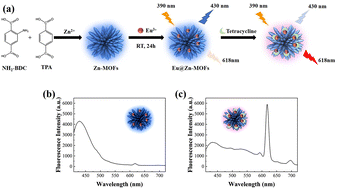A post-synthetically modified Eu@Zn-MOF for ratiometric fluorescence detection of tetracycline in tap water†
Abstract
In this study, a novel Eu3+ functionalized zinc metal–organic framework (Eu@Zn-MOF) probe has been prepared by the post-synthetic modification method. Eu@Zn-MOF exhibited a strong blue fluorescence emission band of the Zn-MOF and a weak characteristic emission of Eu3+ under 390 nm excitation, which were innovatively used to construct a ratiometric fluorescent probe for tetracycline detection. Upon addition of tetracycline, the fluorescence of the Zn-MOF was quenched because of the inner filter effect between tetracycline and Eu@Zn-MOF, while the fluorescence of Eu3+ was enhanced owing to the “antenna” effect between tetracycline and Eu3+. Based on the ratio of fluorescence intensities, efficient detection of tetracycline was achieved. The results indicated that the ratiometric fluorescent probe has an excellent selectivity toward tetracycline over various interferents. It was found that there is a good linear relationship between the fluorescence intensity ratio (F618/F430) and the concentration of tetracycline ranging from 0.1 to 22.5 μM with a detection limit of 33 nM. Meanwhile, the color change of the solution from blue to light pink under an ultraviolet lamp can be observed by the naked eye. The assay was successfully used to detect tetracycline in tap water samples with a recovery of 97.1–100.6%.



 Please wait while we load your content...
Please wait while we load your content...